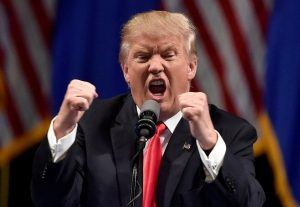by Ali Minai
 April 2018: ‘Tis the Season of Giddiness in Democratlandia. Republicans are saddled with a widely despised President and riven by internal dissension. The Republican leadership in Congress is lurching from fiasco to fiasco – interrupted briefly by one great “success” on tax cuts. The zombie candidates of the Tea Party are still stalking establishment Republicans across the land. And, somewhere in his formidable fastness, the Great Dragon Mueller is winding up for the fiery breath that will consume the world of Trumpism like a paper lantern. And a Blue Wave – nay, a Tsunami – is headed towards the Republicans in Congress, looking to engulf them in November.
April 2018: ‘Tis the Season of Giddiness in Democratlandia. Republicans are saddled with a widely despised President and riven by internal dissension. The Republican leadership in Congress is lurching from fiasco to fiasco – interrupted briefly by one great “success” on tax cuts. The zombie candidates of the Tea Party are still stalking establishment Republicans across the land. And, somewhere in his formidable fastness, the Great Dragon Mueller is winding up for the fiery breath that will consume the world of Trumpism like a paper lantern. And a Blue Wave – nay, a Tsunami – is headed towards the Republicans in Congress, looking to engulf them in November.
Time passes, and it is October. Anguish is all around. After snatching children from their parents and imprisoning them in cages, after giving a wet kiss to Kim Jong Un and worse to Putin, after having his former campaign manager convicted of crimes and his fixer plead guilty, after a virtual torrent of lies, after reports of a still devastated Puerto Rico and newly devastated Carolinas and Florida – after all this and more, Trump is more popular than ever in his presidency, Brett Kavanaugh is on the Supreme Court, and the Blue Wave is beginning to look more like an eddy. To be sure, Trump is still spectacularly unpopular compared to past presidents, with disapproval numbers at 50% of higher, but he seems to be rising. Rising! The very word is like a knell of doom. As Trump himself might say, “What the hell is going on?”
First of all, probably an over-reaction. A large part of US electoral outcomes can be ascribed to structural factors, such as the fact that 26 of the 50 states have conservative majority populations. Yes, these 26 states may add up to only 47% of the US population, but they elect 54% of the US Senate, and that cannot change. The number of reliably liberal states is much smaller – only 16 – and, though they account for 42% of the population, they only elect 32% of the Senate. The remaining 8 states – comprising 11% of the population – swing with the season, but supply 16% of the Senate. Thus, Democrats start off with a huge disadvantage in the Senate even in the best of times. Demographic forces will gradually change this situation, but slowly. Meanwhile, Democrats, as the liberal party, will always be facing the bitter choice of either accepting conservative senators in their own ranks or remaining a permanent minority in the Senate. Four decades of asymmetric political warfare has also left Republicans in control of most state houses, which they have used to gerrymander districts and pass laws to disenfranchise Democratic voters. That too is hard to change because these factors are custom-designed to perpetuate Republican majorities. But all is not lost for Democrats here. Read more »
